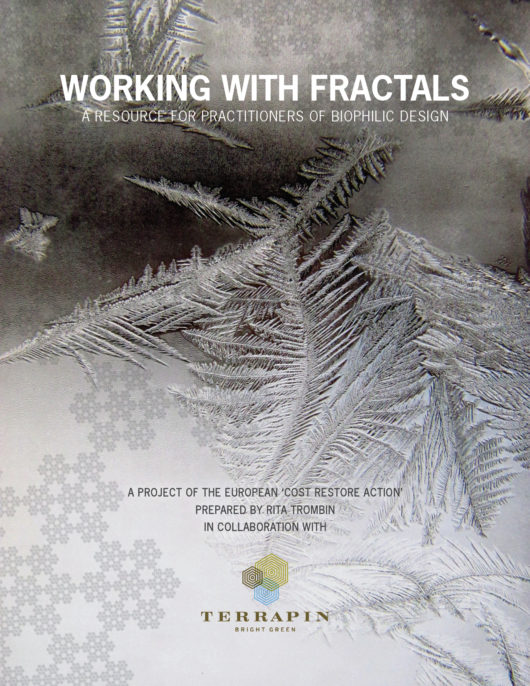Terrapin Report
Working with Fractals
A resource for practitioners of biophilic design
Abstract
Fractal patterns are an intricate ubiquitous machinery behind nature’s order, allowing for many of its complex processes to occur. In nature, complexity and irregularity is actually governed by underlying pattern and order. For context, the 14 Patterns of Biophilic Design (2014) classified fractals as one of many analogues for nature’s propensity for ‘Complexity and Order’, as to indicate “rich sensory information that adheres to a spatial hierarchy similar to those encountered in nature”. Yet science and mathematics tell us there is so much more going on with fractals that they could stand alone as their own pattern or, perhaps more accurately, as a thread through nearly any biophilic experience.
The unique trademark of nature to make complexity comprehensible is underpinned by fractal patterns, which apply to virtually any domain of life. Within the built environment, fractal patterns may present opportunities to positively impact human perception, health, cognitive performance, emotions and stress through. Yet, designing with fractals can also come with implementation challenges.
This paper provides a high-level conceptual framework for thinking about designing with fractals, and for promoting restorative and satisfactory environments, with a focus on the indoor environmental quality. The paper includes primary scientific research on fractals, perception and health, metrics and terminology used to discuss fractals, and perspectives on design, technology and other factors than may influence the creation of fractal patterns for design projects.
See the Italian translation here.
Acknowledgements
Author
Rita Trombin
Supervisor & Editor
Catherine O. Ryan
Contributors
Belal Abboushi, Pacific Northwest National Laboratory (PNNL)
Luca Baraldo, COOKFOX Architects DCP
Bethany Borel, COOKFOX Architects DCP
Bill Browning, Terrapin Bright Green
Judith H. Heerwagen, University of Washington
Giammarco Nalin, Goethe Universität
Kari Pei, Interface
Nikos Salingaros, University of Texas at San Antonio
Catherine Stolarski, Catherine Stolarski Design
Richard Taylor, University of Oregon
Dakota Walker, Terrapin Bright Green
Emily Winer, International Well Building Institute
Citation
Rita Trombin. Working with fractals: A resource for practitioners of biophilic design. New York: Terrapin Bright Green, 31 December 2020.
Partners
This paper is the result of support from several partners and research entities.
CA COST Action CA16114 | REthinking Sustainability TOwards a Regenerative Economy (RESTORE)
COST (European Cooperation in Science and Technology) is the longest-running European framework supporting trans-national cooperation among researchers, engineers and scholars across Europe.
Eurac undertakes interdisciplinary research that challenges conventional ways of thinking and is focused on three major themes: (1) regions fit for living in, (2) diversity as a life-enhancing feature, and (3) a healthy society.
International Living Future Institute | Biophilic Design Initiative
ILFI has seen a demonstrated need among the Living Building Challenge community for Biophilic Design resources that can take the practice from theory to reality. The initiative aims to achieve the goal of broad adoption of Biophilic Design among the design community, building owners and cities.

